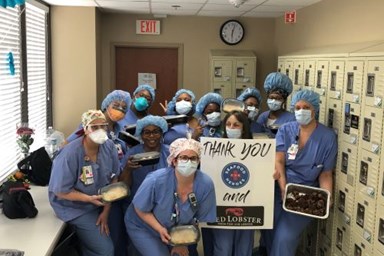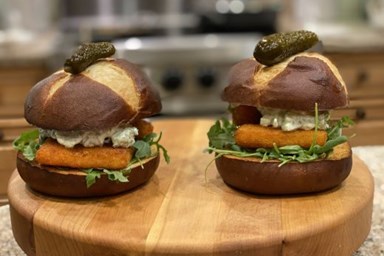Craig Morris , April 21, 2020
Finding our Happily Ever After-COVID Ending

A couple weeks ago, our fearless Association of Genuine Alaska Pollock Producers Communications Committee Chair Margery Schelling of American Seafoods—a classically trained marketing veteran out of the CPK space—wrote a blog encouraging all marketers and brands to use this time to prepare for our new normal. Margery hypothesized, and I agree, that many of the consumer practices and preferences being shaped right now during these unprecedented times have the strong potential to become ingrained; to become habit.
I couldn’t agree more with Margery. So, what does this mean for Wild Alaska Pollock and how do we prepare? Here’s some of my thoughts:
- Prolonged economic instability: the World Economic Forum believes it could take the United States three years for its economy to fully recover from COVID-19. But, WEF also believes that once people return to work and consumers start spending again, the economy will bounce back rapidly. I think now is the time to both return and re-imagine. We need to have plans in place (and GAPP is working on this) to help segments or channels most affected rapidly recover and get back to “normal” as quickly as possible. But this is also a time for imagination and discovery. How can we reinvent ourselves, reposition ourselves and relaunch ourselves? Wild Alaska Pollock is unique in that we have some channels where we aren’t currently widely ingrained (like White Tablecloth Restaurants—although we are moving the needle there as the Wild Alaska Pollock Week in Seattle held right before COVID became a household name showcased). But, how can we get chefs and others to reimagine our product and relaunch ourselves more widely in this channel by being seen as a collaborative partner during challenging times?
- A return to comfort: COVID-19 reintroduced us to the concept of comfort in food. Partly because we are eating at home and partly because we have truly needed “comfort” in this time, we have turned to Oreos, instant mashed potatoes, grilled cheese and ice cream…and carbs! So many carbs! A recent survey revealed 52% of adults who eat crisps and savory snacks state that they do so to boost their mood. I don’t think that the return to comfort is going to go away, at least not right away. I think consumers are hooked (excuse the pun). Comfort food is hard to give up. And COVID won’t end with the flick of a switch. It will wind down gradually. How can we capitalize on this trend as an industry while recognizing that it may not last forever? GAPP is working on some delicious sinful recipes that play to the comfort food audience but is also ready to rapidly shift back to healthy cooking when consumers remember their health and get concerned about waistlines and weight gain.
- The Return of the Recipe: Search analytics and recipe editors confirm a seemingly obvious trend underway in our country. People are cooking again. A huge spike is underway in people learning to cook for the first time or relearning cooking skills after a long absence. Confined to their homes, unable to indulge in their favorite restaurants, people are fashioning meals out of actual ingredients. Heck—even DoubleTree (in a brilliant marketing move) released their top-secret chocolate chip cookie recipe so people could make them at home. We don’t know if everyone who became a home chef in March will still be one in March 2021, but we can expect some of them will be. Regardless, the need to deliver new recipes and capitalizing on the interest (or necessity) to cook at home will continue. The more we can do to meet consumers where we are, the better. And—even if people can return to restaurants, they may not be able to afford to given the economic climate. So, the more we can help consumers recreate their favorite seafood or fish dish at home and teach them how easy Wild Alaska Pollock is to cook—the better we are!
- Return of Pantry and Freezer Purchases: We are likely in the midst of creating the next generation of people, who, like their grandparents, kept staple ingredients in the house so they could whip up a dish when they needed it or weather another significant disruption just like people who lived through the Great Depression (see my last blog on the subject). According to Mintel, “Stocking up the freezer or pantry is a way for people to take control of what they can in a situation where everything else feels increasingly out of control.” Well, the good news there is that Wild Alaska Pollock is readily positioned in the freezer areas of the store. So, now we need to help people find, try and buy us because once they do they’ll no doubt fall in love.
- Return of the Shopping List: If you’re like me, I never go to the store without a list. The same cannot be said for some of my close friends. Partly in conjunction with the recipe trends, and partly due to the acute need today of having a grocery trip carefully planned, the concept of making a list before going to the store is bound to stick for a while. People will be more planful about their shopping and may be making their decisions at home instead of just in the store. In-store marketing will become a less prominent part of the consumer journey. While not a permanent trend, in the near-term, retailers are anticipating there will be fewer, larger-ticket trips to the grocery store in a month. Grocery trips will be more stock-up in nature vs. impulsive, daily trips without a meal plan. So, to be successful, we’ll need to make sure that Wild Alaska Pollock is positioned to be included in consumer’s meal plans before they shop. We need to be top of mind and readily available.
- Grocery pick up/delivery: For obvious reasons, people are experiencing grocery “drive up” services and delivery services for the first time. Whether through Amazon or their local grocers, they are finding ways to never set foot inside the store. This was already a burgeoning offering thanks to competitive trends from Walmart, Target and Amazon. In the short term, this will be seen as a way to stay safe from coronavirus, but longer term could set in as a new permanent pattern of convenience. It means shoppers will make many or all of their grocery decisions on their computers/smart phones at home instead of in the aisles. It may surprise you to learn the SARS epidemic of 2002 gave birth to Alibaba because of the demand for home delivery. So, again, we’re going to have to shift our consumer marketing efforts to be much more digital friendly and make sure we’re optimized on all delivery and grocery store apps.
- Life is Short, so YOLO: It is entirely possible that the psychological outcome of this crisis will lead to actions that turn the Gen Z cry of “YOLO” (you only live once) into a multi-generational epiphany that life really is short. With people losing jobs, losing loved ones, losing their retirement savings, there is likely to be a shift on how people choose to confront certain issues related to their own mortality. This could manifest in relaxing attitudes about stereotypical healthy eating: “Eat a cookie, you’re going to die someday anyway.” Or it could create a more dogged pursuit of protecting the next generation: “I just survived coronavirus; I’m not going to stand by and watch greenhouse gas abusers end the world for mygrandkids.” For me, this translates to the need for our marketing efforts to be fun, creative and more than anything nimble. I don’t know that we know exactly how people will react to the new normal and we need to be flexible enough to shift strategies to capitalize on opportunities.
I know it’s hard to see the light at the end of this tunnel, but trust me, it’s coming. And what we do now to prepare will help set our industry up for success. Now is the time to prepare and come together and get creative. Now is the time to recognize that our new normal is going to be an entirely new reality and to get comfortable with being (at least in the short term) uncomfortable.
Trust me, there’s a happy ending at the end of this story and I think Wild Alaska Pollock will win the day. We just need to figure out how to let our hair down, climb down from the tower and fight the COVID-19 dragon head on.
But, we’ll get there.

